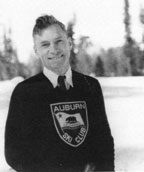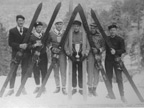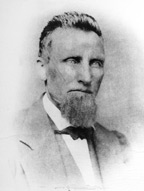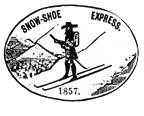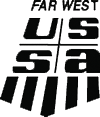 |
||
 |
 |
|
![]()
|
History of Far West Ski Association In 2002, the FWSA Awards Book was redesigned and expanded for the annual Convention. The book and this history is a work in progress as we continue to uncover more of our roots. The book was again redesigned for the 75th Celebration of Far West's Snowsport history. You can download the Awards Book that was presented at the 2005 Convention here. Skiing in California One of the most famous skiers of that era was Snowshoe Thompson who carried the mail from 1856 for 20 years from Placerville to Carson Valley, a distance of 90 miles, with a mail sack as heavy as 100 pounds on his back. It wasn’t long before California miners were challenging each other to spur-of-the-moment downhill races when the snow kept them from their work. The rivalry easily spread to other camps and a racing circuit was established. Each camp had its “aces” who rode the 12 foot boards all out for the honor of their camp. Recipes for “doping” [waxing] were highly guarded secrets and often determined who would win or lose. Prizes of silver belt buckles and cash were common. Betting was intense; spirits were high; and après ski revelry could last through the night. These early California competitions took place 15 years before the first European tournament. The mining camps organized into various clubs with rules of conduct for race events. The Alturas Snowshoe Club of La Porte claims to be the oldest competition ski club in the world, since the world’s first downhill races were held on their Lexington Hill in 1866. By 1910, Truckee, California had a jump, toboggan chutes and a ski hill. As a means of making money, the Southern Pacific Railroad established Truckee as a destination. Visitors from San Francisco and Oakland arrived by train and stayed in Pullmans which were parked on a side track. The trains were equipped with special baggage cars converted into a ski shop or stripped for dancing. These “Snowball Specials” rolled until the start of World War II. California Ski Association But skiers in the state wanted an opportunity to secure a sanctioned meet and invite the world to experience what California had to offer. To do this, California needed a statewide organization affiliated with the National Ski Association. A special meeting of the Winter Sports Committee of the California State Chamber of Commerce was held on Tuesday, October 7, 1930 at the Palace Hotel in San Francisco. Wendell Robie of Auburn Ski Club was elected president of the newly formed California Ski Association. Others elected were Frank Deuprey of the California State Chamber of Commerce, Secretary; W. A. Wadsworth of Los Angeles, Treasurer; Vice Presidents: Don Tresidder, Yosemite; Herbert Fleishhacker, Jr., San Francisco, for the northern part of the State; George L. Eastman and J. B. Hanson of the Viking Club, both of Los Angeles, for the southern part of the State. The election of the directors was left to the four originating ski clubs— Truckee Ski Club, Auburn Ski Club, Yosemite Winter Club and Viking Ski Club of Los Angeles— to name two each from their respective clubs. A resolution was passed asking that there be an entrance fee of $20 for each club desiring to affiliate with CSA. California was admitted into the National Ski Association at the annual convention held on December 14, 1930. In 1931, Wilbur Maynard, representing CSA, went east and was successful in securing the NSA Championships in Jumping and Langlauf [cross-country] for 1932. CSA organized its first annual championships on February 21-23, 1931 at the Olympic Hill of the Lake Tahoe Ski Club. This event was sanctioned by NSA and used as the 1932 US team “California Olympic Tryouts.” Post War Growth In October 1946, at the CSA convention in Santa Cruz, the constitution was changed and the bylaws revised creating a competition committee. CSA established the formation of the sixth district within the state that would meet monthly. An Area Development committee was formed in the hopes of securing the opening of the San Gorgonio Area for skiing. Three years later, the US Forest Service released their prospectus outlining a proposal for the initial development of Mineral King. Prior to the war, CSA had established a committee to work out a “Plan for Certification of Ski Instructors” and to standardize teaching. In 1947, the first professional ski instructor organization in the US was the California Ski Instructor’s Association organized at Donner Summit. Far West Ski Association The primary function of Far West was sanctioning tournaments to be held within the Far West region. This involved scheduling dates, selecting the judges, and regulating the events. Another important function of Far West was raising funds in Winter Olympic and FIS years to help finance USA teams who participated in ski and jump events. By 1960, FWSA had grown to 80 affiliated clubs, with approximately 4,500 members of whom 1,250 were competitive skiers. The emphasis of the association was moving more toward recreation. Two things contributed greatly to the growth of skiing in the Far West during the early 60’s— the Far West Flight Charter Program and the televised coverage of the VIII Winter Olympics at Squaw Valley. Thousands of new California skiers joined the ranks and in1966 FWSA implemented bylaw changes at its Las Vegas Convention, enabling the organization to expand its professional staff and develop a broad spectrum of programs attractive to recreational skiers. Far West developed a marketing approach, which proved successful in attracting more members. These benefits included dry land training, club and league racing, membership benefits, a newspaper, public affairs programs, insurance, and travel vacation ski weeks. The Beginning of Councils The council development program of the 70s, headed by John Watson, hoped to bring the purposes of the councils and the association into alignment within Far West. This process began in 1969 with the Southern Council which regarded itself as a district arm of the association and promoted the programs of the Far West, even creating council positions mirroring the program positions at the regional level. This resulted in a synergistic benefit to both council and Far West. The program also concentrated on encouraging the smaller councils to become more active in the Far West programs and solicited nonaffiliated councils to join. Strenuous but ultimately unsuccessful attempts were made to bring in councils such as Arizona, Sacramento, and Tahoe-Reno [latter as the Sierra Nevada Council]. As a result of this emphasis on smaller councils, there was a spinoff from Southern Council of the Inland and Orange Councils in 1971. Southern was a huge council, including over 60 clubs meeting as far east as San Bernardino, south to cover Orange County, and north to Santa Barbara and even Mammoth Mountain! The realignment of Southern Council [later renamed Los Angeles Council] made it far easier for club representatives to make it to meetings and ensure meaningful involvement and activities. Far West Programs By the mid 70s, Far West expanded to the point where recreational skiers far outnumbered competitive skiers. This was a dramatic contrast to USSA and the other ski associations, where competitive skiing continued to dominate. A conflict began to develop between USSA and Far West because only 20% of members club elected to affiliate with Far West, and hence USSA. While clubs were the life line of Far West and provided the volunteers needed to run the Far West programs and raise money for the US Ski Team, the discord continued. Far West Ski Competition Today, Far West Skiing, a division of USSA, is the body that develop young athletes from all clubs in the Far West with the objective of placing elite competitors onto the US Ski Team. Far West Rebuilt The Amateur Athletic Act of 1978 was used to create a national governing body which required a focus on the national competitive effort. The United States Recreational Ski Association [USRSA] was founded as the national recreational organization and Far West withdrew from USSA to began rebuilding the association. Clubs were left to determine which association(s) they wanted to affiliate with – USSA, USRSA, and/or Far West. Meanwhile, the race leagues of Far West formed an independent nonprofit corporation, named the Far West Racing Association [FWRA], to focus on their specialized programs. FWRA continued to generate operating funds through sponsorship, the Los Angeles Ski Dazzle ski swap, and race fees. The president of FWRA currently serves as a member of the Far West Board of Directors. On November 6, 1984, the Executive Committee of Far West met to decide on the direction the association should take. This committee proposed a new set of bylaws that were approved at the 53rd Annual Far West Convention held at the Oakland Airport Hilton, May 17-19, 1985. Far West was restored as an all-volunteer organization with Janie “Frankie” Hansen as president. To encourage clubs to stay with Far West, dues were waived and are not required by clubs as long as they belong to a member Council. The Modern Far West The 90s saw the rebuilding of the Far West travel program by Gene Fulkerson with both domestic and international trips being offered. The pubic affairs program under Mike Sanford was rejuvenated and has assumed a significant role on the national stage on a wide variety of issues—area development, safety, transportation, insurance, taxation, consumer advocacy and snowsports history. The council development program has had dramatic successes in the last decade. Arizona Ski Council and Northwest Ski Club Council [then Portland Area Ski Club Council or PASCC] joined Far West in 1991 and 1992, respectively. Meanwhile Sierra Council built a strong race program and in 1996 once again became actively involved in Far West. In 2000, New Mexico Council joined the association as the tenth council and Far West became one of the founding members of the National Ski Council Federation [NSCF]. Communication and networking have been facilitated with local and national industry organizations, such as the United States Forest Service (USFS), National Ski Areas Association (NSAA) and the Pacific NSAA, National Ski Patrol (NSP), International Ski History Association (ISHA), National Ski Journalists Association, United States Ski Team (USST) and Snowsports Industries America (SIA). The Future
As Far West celebrates their 75 years of Snowsport history, they continue to evolve and re-invent themselves. Thanks to the following contributors: Jane Wyckoff, John Watson, Mike Sanford, Jane “Frankie” Hansen, Gene Fulkerson. |
|||||||||||||||||||||||
Email us at info@pacificrimalliance.org
Contents of this site Copyright © 1997-2019 by Pacific Rim Alliance. All rights reserved.
Site designed & maintained by Graphic Dezignz. Last updated October 17, 2017.
 |
 |
Skiing is a Dance in which the Mountain always Leads

